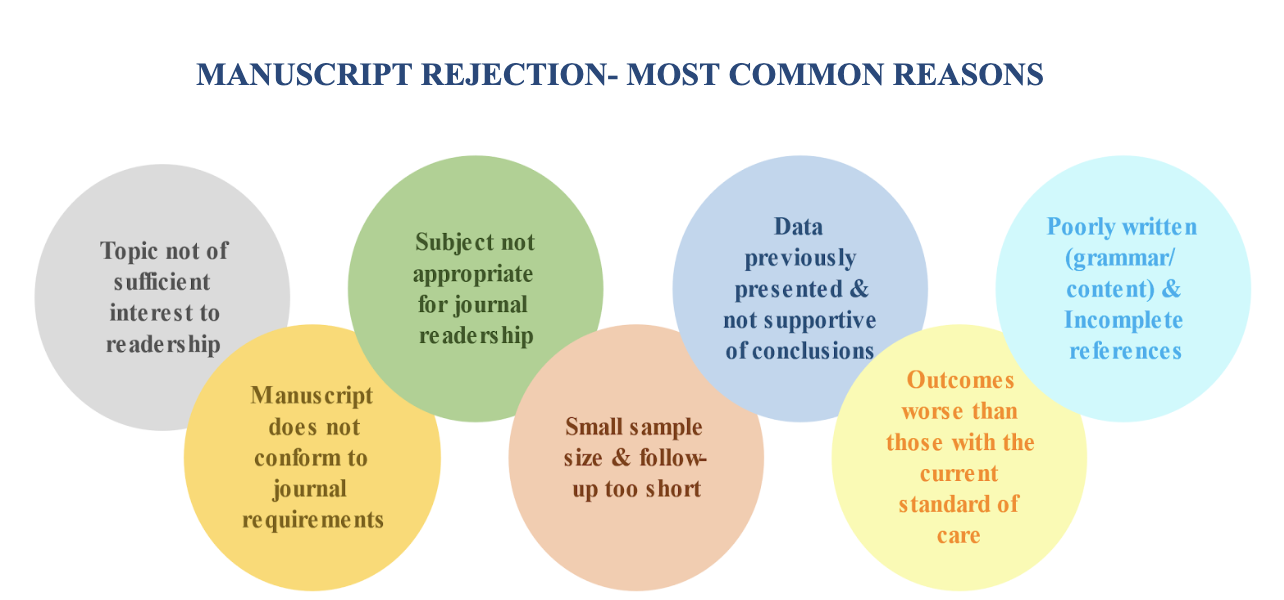Registered Address
Chandigarh-160035, India
Work Hours
Monday to Friday: 9AM - 6:30PM



“The journey of a thousand miles begins with one step”
– Lao Tzu
In the contemporary era, research and publishing have gained importance in the medical and scientific fields. Keeping up with the most current findings from the research community is essential for future publication success. Both beginners and experienced writers should always pay attention to what is published, what other people are reading, and where it is published. This not only helps them to enhance their research but to write confidently. The pathway of a manuscript to get transitioned into a published article is not easy. In addition, the pressure to publish, the high journal rejection rates, and the lengthy wait for a publication decision can lead to researcher self-doubt, which affects research productivity. Therefore, the key goal for authors should be to include everything in an error-free and succinct manner. Through this blog, we are highlighting the various aspects that can enhance the success rate of the manuscript getting approved and also discussing certain tried-and-true manuscript-writing strategies that can help the project to get the attention it deserves.
STICK TO THE FUNDAMENTALS: A STEPPING STONE TO PROGRESS
Simple and Reliable
When it comes to research, it is always important to know what to publish. However, the simpler and more transparent the document, the better the work will be presented.
Command of the Language: English
While drafting the manuscript in English, it is important to ensure that the message is simple and clear but expressive enough to be understood. The use of basic sentence structure, proper grammar, and accurate word usage elevates the document to the next level. Vague papers are often rejected unless the science is truly outstanding.
Don’t Plagiarize
To ensure that there is no existing content published, the majority of submitted papers are checked for plagiarism. Hence, avoid copying and pasting words or chunks from previously published papers. Make sure that any borrowed material is accompanied by a reference or reworded. When in doubt, paraphrasing might be helpful.
Swap and Share Ideas
Keeping in touch with the other authors on a regular basis for secondary review improves the direction of the work. Their input can assist in identifying unnoticed flaws, spotting mistakes, and creating a new set of ideas. It might also help prevent repetition.
Revise Thoroughly
Revising the work with care can assist in identifying minor errors. Furtherly, this helps to prevent multiple phases of review throughout the publication process. If the author’s work has the potential to be published, they will be asked to make modifications.
PERFORM EVERY ACT: TO ACHIEVE SUCCESS
Specific and Accurate Title
Selecting an appropriate title is the most important in publishing. It should provide an overview of the paper’s topic and reflect the content of the paper within. It should be more precise, specific and jargon-free.
Extensive literature review
A literature search is an essential component of every evidence-based study. It is always necessary to conduct comprehensive research, acquire new studies that are being conducted and incorporate the data. Try to search for material on the internet (through various search databases), in libraries, on hard copies, and so on.
Journal Selection
The type of journal selected, either national or international, with or without an impact factor, has a substantial influence on how soon the work gets published. Consider the elements such as publication fee, author instructions, editorial board, publication method, etc.
Use of the Journal Template
Templates definitely contribute to the improvement of the research paper throughout the writing process and provide the document with a more professional look. Using the template from the beginning will save a lot of time, make the job organized and simple to understand.
Optimal Content Overview
The manuscript should be a balanced amalgamation of new concepts, research-based literature, suitable methodology, statistical analysis, and extensive discussion. Always follow the journal’s suggested outline. The inclusion of tables, figures, and graphs also adds value to the paper.
Reviewer’s Insight
Before submitting the article, consider the viewpoint of a reviewer who is competent enough to recognize mistakes, assess judgements, and have a novelty and broad perspective. Reading other articles can help to become a better critic.
An Error-Free Submission
Before submitting a manuscript, be sure to proofread it and ensure that the title, abstract, main file, reference style, and supplementary files follow the author’s guidelines. Keep everything that has to be included prior to submission, such as a cover letter, contributor form, disclosure form, etc., to minimize delays during submission.
Prioritize Excellence
“Publishing a lot is detrimental to quality.”
Instead of concentrating on a journal’s impact factor, the writer should try to improve its impact.
More noticeable work is displayed in high-quality journals, such as international journals. Also, high-quality content will be more likely to appear in search results.
Embrace Rejection
“Failure is simply the opportunity to begin again, this time more intelligently”. The correct attitude is to accept it, figure out the reviewers’ suggestions, and revise the paper. The degree of expertise and information that each reviewer possesses varies. To improve further, learn from the previous lessons, deal with them, and look for another journal that will accept the paper.

Other Important Suggestions:
Written by:
Dr. Madhuri Mukhe